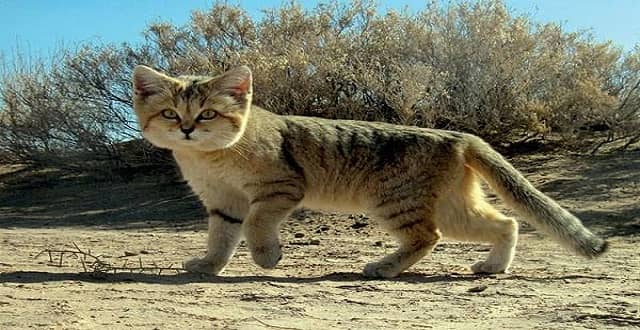Finding the sand cat, also known as Felis margarita, is challenging, if not downright impossible.
This desert cat, often referred to as the dune cat, is not only as stealthy and sly as a house cat, but it has evolved with stealth-like abilities. In addition to having special foot pads that virtually leave no trace in the sand, these sand cats also crouch down and close their eyes when any light is shone on them, making them invisible to eye tracking devices. Sand cats are difficult to spot in their desert habitat due to their light coats, special foot pads, and other characteristics.
This may help to explain why it has been so difficult for scientists to estimate the number of cats that exist within the geographic range of the species, which encompasses areas of north Africa, the Arabian Peninsula, and central Asia. Back in 2005, it was thought that less than 250 sand cats were left in the United Arab Emirates, where one hasn’t been seen in the wild in more than a decade. However, there was no concrete information about their numbers. Shakeel Ahmed, an assistant scientist at the Abu Dhabi Environment Agency, and a few of his coworkers made the decision to look for some of the endangered felines as a result.

The National’s Roberta Pennington says that the researchers installed a total of five video traps in the preserve in March 2015 while working in the Baynouna protected zones. Then, they placed cans of cat food flavoured with chicken and fish not far from the motion detectors. (Ahmed adds out that they mostly utilised chicken cat chow because a prior poll in Saudi Arabia revealed that cats there considerably preferred it.)
The first sighting of a sand cat was made by the researchers one month later. By December of last year, after adding four more cameras, they had gathered a total of 46 photos of three sand cats—two females and a male. ents.
In a recent publication that was published in The European Journal of Wildlife Research, the researchers discuss their results. About 40% of the sightings occurred during the full moon, with the majority occurring between midnight and six in the morning. This is because cats spend the day sleeping in dens and only emerge at night to hunt tiny reptiles and rodents.
Researchers will be able to determine the uncommon cats’ preferred habitats and get a better understanding of their population density thanks to the study.
According to Newby, “it is obvious that field studies will all be incredibly important in developing conservation plans for the sand cats and their habitat, as well as identifying those locations and their extent that may be turned into protected areas to conserve the cats.” More investigation on the sand cat’s lifestyle is required by scientists in order to designate an appropriate protected area.
What other benefit does studying sand cats have? These cats are stunning (more like super-cute, really), according to an editorial in The National, and they may act as the Arabian Peninsula’s conservation effort’s symbol.
The editors claimed that because cats are becoming more and more well-liked worldwide, “our sand cats are the right face for this message of persistent discussion commitment.”
